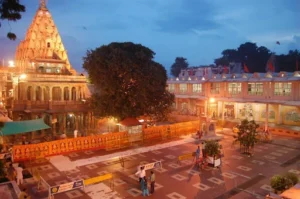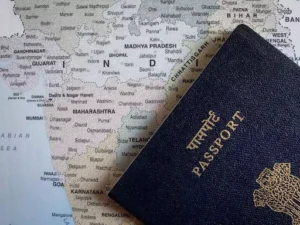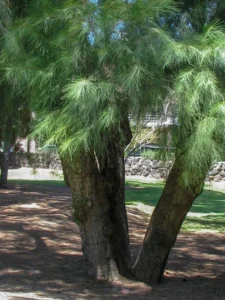UPSC GS 1
Mahakal Temple
- News: At least two persons were killed and four people have been injured after a boundary wall near Mahakaleshwar Temple in Madhya Pradesh’s Ujjain collapsed recently.
- Definition: Mahakal Temple is among the twelve celebrated Jyotirlingas in India.
- Location: It is located in Ujjain (MP), on the banks of the river Kshipra.
- Establishment:
-
- When did the Mahakala temple first come into existence, is difficult to tell. However, Puranas narrate that it was first established by Prajapita Brahma.
- The punch-marked coins of Ujjain, belonging to 4th-3rd c. BC, bear the figure of Lord Siva on them.
-

- Architecture:
-
- One of the 12 Jyotirlingas in India, the lingam at the Mahakal is believed to be swayambhu (born of itself).
- The idol of Mahakaleshwar is dakshinamurti, facing the South. This is a unique feature, upheld by tantric tradition to be found only in Mahakaleshwar among the 12 jyotirlingas.
- The temple complex comes with a spacious courtyard that is adorned with finest sculptures that are believed to be influenced by Chalukya, Maratha, and Bhumija styles of structural design.
- The temple is spread across five levels, and witnesses a huge number of devotees during the Maha Shivaratri festival.
-
- Literary Mentions:
-
- The glory of Mahakaleshwar temple has been vividly described by Kalidasa.
- Kalidasa in Raghuvansam describes this temple as ‘Niketana’.
- There is reference to the appointment of prince Kumarasena by king Chanda Pradyota in 6th c. BC for looking after the law and order situations of Mahakala temple.
- The glory of Mahakaleshwar temple has been vividly described by Kalidasa.
-
Read also: Understand Indian Pension System: A Complete Overview | UPSC
UPSC GS 2
Overseas Citizen of India
- News: The Consulate General of India in New York has clarified that rumours circulating on social media regarding OCIs becoming reclassified as “foreigners” are false.
- Overseas Citizens of India (OCIs):
-
- These are individuals from foreign countries with ancestral ties to India.
- The OCI Card scheme was introduced in August 2005 by amending the Citizenship Act, 1955.
- OCI status aims to enhance the integration of the Indian diaspora into the global community while preserving their individual connections with India.
-
- Can A Person Registered As An OCI Be Granted Indian Citizenship?
-
- As per the provisions of section 5(1) (g) of the Citizenship Act, 1955, a person who is registered as an OCI for 5 years and is residing in India for 1 year out of the above 5 years, is eligible to apply for Indian Citizenship.
-
- OCI Card Eligibility: The Government of India defines an OCI card holder:
-
- who was a citizen of India at the time of, or at any time after 26th January, 1950; or who was eligible to become a citizen of India on 26th January, 1950; or
- who belonged to a territory that became part of India after 15th August, 1947; or
- who is a child or a grandchild or a great grandchild of such a citizen; or
- who is a minor child of such persons mentioned above; or
- who is a minor child and whose both parents are citizens of India or one of the parents is a citizen of India.
-

- Benefits of OCI Card:
-
- Section 7 B of the Citizenship Act allows individual multi-purpose, multiple entries and a lifelong visa for visiting India whereas for a PIO card holder, it is only valid for 15 years.
- Receives equal rights with non-resident Indians (NRIs) in financial, economic and educational fields.
- Parity with NRIs in the matter of inter-country adoption of Indian children.
- No restriction from foreigner registration obligation for any length of stay in India.
-
- Restrictions on OCI Card:
-
- They don’t have the right to acquire agricultural land and plantation property or farmhouses.
- OCI card holders can’t vote.
- The OCI card holders cannot be a member of a Legislative Assembly or of a Legislative Council or of Parliament.
- Certain regions and places are considered the restricted zone for them.
- OCI card holders cannot hold constitutional posts in India like President, Vice President, Judge of the Supreme Court or High Court.
- OCI card holders cannot hold Government posts in India.
-
- Who cannot be an OCI?
-
- An applicant is not eligible to get an OCI card if his/her parents or grandparents have ever been a citizen of Pakistan or Bangladesh.
- However, the spouse of foreign origin of a citizen of India or spouse of foreign origin of an OCI, whose marriage has been registered and subsisted for not less than two years, can apply for an OCI card.
- Foreign military personnel either in service or retired are also not entitled for grant of OCI.
-
National Centre of Excellence (NCoE) for Animation, Visual Effects, Gaming, Comics, and Extended Reality (AVGC-XR)
- News: The Union Cabinet has approved the establishment of the National Centre of Excellence (NCoE) for Animation, Visual Effects, Gaming, Comics and Extended Reality (AVGC-XR).
- Definition:
-
- The National Centre of Excellence, or NCoE, is an initiative approved by the Union Cabinet to establish an institution in Mumbai focused on “Animation, Visual Effects, Gaming, Comics and Extended Reality,”.
-
- Partnership:
-
- NCoE will be set up as a Section 8 Company under the Companies Act, 2013 in India with Federation of Indian Chambers of Commerce & Industry and Confederation of Indian Industry representing the industry bodies as partners with the Government of India.
-

- Nomenclature:
-
- Provisionally named the Indian Institute for Immersive Creators (IIIC).
- It will be modeled after renowned institutions like the Indian Institutes of Technology (IITs) and Indian Institutes of Management (IIMs).
-
- Features:
-
- The IIIC is designed to be a premier institution offering state-of-the-art infrastructure and technology.
- The centre will provide specialised training in immersive technologies, including Virtual Reality (VR), Augmented Reality (AR), Mixed Reality (MR), and 3D modelling and animation.
- The NCoE is expected to drive “explosive growth” in India’s AVGC sector, which has already shown immense potential through films like RRR, Baahubali, The Lion King and Avatar.
- The centre aims to generate around 5 lakh jobs.
-
‘Swachhta Puraskar 2024’
- News: Rashtriya Ispat Nigam Limited (RINL) recently presented the Swachhta Puraskar 2024 to recognize departments that contributed to the Swachh Bharat initiative.
- Introduction:
-
- The Swachhta Puraskar 2024 is a prestigious award by RINL, aimed at acknowledging departments that have made significant contributions to the Swachh Bharat mission.
-
- Alignment with National Initiatives:
-
- This award is closely linked to the Swachh Bharat Abhiyan (Clean India Mission) launched by the Indian government, focusing on cleanliness and sustainable practices within the organization.
-
- Part of CSR Efforts:
-
- The initiative is part of RINL’s broader Corporate Social Responsibility (CSR) agenda, emphasizing environmental sustainability, employee welfare, and community development.
-
- Focus Area:
-
- The awards are part of the Swachhta Hi Seva 2024 campaign, which encourages hygiene and cleanliness at the workplace.
-
- Departmental Involvement:
-
- Departments were recognized for their proactive efforts in maintaining cleanliness, managing waste, and implementing sustainable practices at the steel plant.
-
- Recognition of Leadership:
-
- Heads of Departments (HODs) and their respective Swachhata Coordinators or representatives received the Swachhta Puraskar for their dedicated role in ensuring a clean working environment within RINL.
-
- Commitment to Cleanliness:
-
- The award reflects RINL’s commitment to creating a clean and healthy environment for its employees while promoting sustainable industrial operations.
-
- Motivation for Future Efforts:
-
- It acts as both recognition and encouragement for continued cleanliness efforts and the adoption of sustainable practices at RINL.
-
UPSC GS 3
Annular Solar Eclipse
- News: An annular solar eclipse will be visible in parts of South America on 2nd Oct.
- Solar Eclipse:
-
- A solar eclipse takes place when the Moon moves in the middle of the Earth and the Sun.
- The Moon blocks the light of the Sun, either fully or partially, which casts a huge shadow on some parts of the world.
- A solar eclipse can only occur during the new moon, when the Moon and Sun are aligned on the same side of Earth.
- While a new moon happens every 29.5 days, a solar eclipse does not occur every month, only taking place two to five times a year. This is because the Moon’s orbit is tilted by about five degrees relative to Earth’s orbit around the Sun, causing the Moon’s shadow to often miss Earth by being too high or too low during most new moons.
-
- Types of Solar Eclipses:
-
- Total Solar Eclipse:
- A total solar eclipse happens when the Moon passes between the Sun and Earth, completely blocking the face of the Sun.
- The sky will darken and people in the path of a total solar eclipse will see the Sun’s corona, the outer atmosphere, which is otherwise usually obscured by the bright face of the Sun.
- A total solar eclipse is the only type of solar eclipse where viewers can momentarily remove their eclipse glasses for the brief period of time when the Moon is completely blocking the Sun.
-

-
-
- Annular Solar Eclipse:
- An annular solar eclipse happens when the Moon passes between the Sun and Earth, but when it is at or near its farthest point from Earth.
- Because the Moon is farther away from Earth, it appears smaller than the Sun and does not completely cover the Sun.
- As a result, the Moon appears as a dark disk on top of a larger, bright disk, creating what looks like a ring around the Moon.
- Partial Solar Eclipse:
- A partial solar eclipse happens when the Moon passes between the Sun and Earth but the Sun, Moon, and Earth are not perfectly lined up.
- Only a part of the Sun will appear to be covered, giving it a crescent shape.
- During a total or annular solar eclipse, people outside the area covered by the Moon’s inner shadow see a partial solar eclipse.
- Hybrid Solar Eclipse:
- A hybrid solar eclipse is the rarest type of solar eclipse.
- It is witnessed when an eclipse shifts between annular and total as the shadow of the Moon moves across the globe.
- In this case, some parts of the world see a total solar eclipse, while others observe an annular solar eclipse.
-
Chikungunya
- News: Chikungunya continues to wreak havoc in Pune as the cases of the mosquito-borne disease are rising. According to the scientists of the National Institute of Virology, the current spike in Chikungunya is caused by the Indian Ocean lineage of the virus.
- Definition: Chikungunya is a mosquito-borne viral disease that causes fever and severe joint pain.
- History: CHIKV was first identified in the United Republic of Tanzania in 1952 and subsequently in other countries in Africa and Asia.

- Transmission:
-
- Chikungunya virus (CHIKV) is transmitted to humans by the bites of infected female mosquitoes Aedes aegypti and Aedes albopictus.
- These two species can also transmit other mosquito-borne viruses, including dengue and Zika viruses.
- The virus doesn’t spread from person to person through bodily contact or saliva, although blood transmission may be possible.
-
- Symptoms: Fever, joint pain, headache, muscle pain, rash, fatigue, nausea.
- Medication: There’s no medication to treat chikungunya. Treatment focuses on managing your symptoms.
Casuarina (savukku) Tree
- News: Six years after the devastation caused by Cyclone Gaja, Vedaranyam taluk, once known for its flourishing casuarina (savukku) plantations, is seeing a revival as farmers prepare for their first harvest in five years.
- Origin: Casuarina trees are native to Australia and were introduced to India in the 19th century. These trees are locally known as “kattadi” and “savukku.”
- Cultivated Species: There are four primary species of Casuarina cultivated globally:
-
- Casuarina equisetifolia
- Casuarina glauca
- Casuarina cunninghamaina
- Casuarina junghuniana
-
- Adaptability and Nitrogen Fixation:
-
- Casuarina trees are known for their nitrogen-fixing ability, making them highly adaptable to various soil types and climatic conditions.
- They can thrive in environments with limited moisture and nutrients, making them ideal for commercial plantations and environmental restoration projects.
-

- Distribution:
-
- Casuarinas are widely grown across tropical, subtropical, and Mediterranean regions due to their resilience and adaptability.
- Their rapid growth makes them a favored choice in diverse environments.
-
- Climate Suitability:
-
- These trees are suited to a temperature range of 10°C to 33°C.
- They grow well from sea level up to altitudes of 1500 meters and can adapt to areas with annual rainfall ranging between 700 mm and 2000 mm.
-
- Soil Requirements:
-
- Casuarina trees prefer light soils and can tolerate calcareous and slightly saline conditions. However, they do not grow well in heavy, clay-like soils.
-
- Uses of Casuarina:
-
- Fuel and Biomass Energy: The wood is commonly used for fuel and is increasingly favored for biomass-based power generation.
- Paper Industry: Casuarina wood is a significant raw material for papermaking.
- Construction: The straight, cylindrical stems are utilized in rural house construction and as scaffolding at construction sites.
- Coastal Protection: Casuarina is a primary species for establishing shelterbelts in coastal areas and windbreaks to protect crops from strong winds.
- Land Reclamation: These trees play a crucial role in rehabilitating mined lands and afforesting nutrient-deficient areas.
-
Pusa-44
- News: PUSA-44 Rice variety is popular among Punjab farmers but it has been causing environmental harm.
- About Pusa 44:
-
- PUSA-44 is bred by the Indian Agricultural Research Institute (IARI).
- It has a growth cycle of 155-160 days from sowing to harvesting.
- The Pusa-44 paddy, transplanted in mid-June after nursery-sowing a month before, can be harvested only towards end-October.
- This delayed harvest leaves very little time for farmers to prepare the fields for sowing the winter wheat crop, which ideally should be done by mid-November.
- As a result, many farmers resort to burning the loose straw and standing stubble left after harvesting using combines.
- The short gap between the harvesting of paddy and the optimal sowing period for wheat is the main cause of stubble burning in Punjab and Haryana.
- This practice significantly contributes to the air pollution in much of northern India, especially between late October and mid-November.
-
- Pusa- 2090:
-
- The Indian Agricultural Research Institute (IARI) has developed a new high-yielding, short-duration rice variety known as Pusa-2090.
- It is a selection from a cross between Pusa-44 and CB-501 and an early-maturing Japonica rice line.
- This new crop matures in 120 to 125 days, while Pusa-44 takes about 155 to 160 days to mature.
- This new crop could help reduce air pollution in Delhi-NCR caused by paddy stubble burning.
-
Peechi -Vazhani Wildlife Sanctuary
- News: A female elephant was found dead, likely due to electrocution, near a tribal colony close to the Peechi wildlife sanctuary.
- Location:
-
- Situated in Thrissur District, Kerala.
- Established in 1958, the sanctuary covers an area of 125 sq. km.
- It is located within the catchment areas of the Peechi and Vazhani dams.
- The sanctuary is part of the Palapilli-Nelliampathy forest range and forms the northern boundary of the Chimmini Wildlife Sanctuary.
-
- Vegetation: The sanctuary hosts a variety of forest types, including:
-
- Tropical evergreen forests
- Tropical semi-evergreen forests
- Moist deciduous forests
- The terrain is undulating, with altitudes ranging from 100 m to 914 m, with Ponmudi being the highest peak.
-
- Flora: There are more than 50 different kinds of orchids, innumerable rare medicinal plants, and trees of high commercial value like teak, rosewood, etc.
- Fauna: The wildlife includes over 25 species of mammals, including:
-
- Carnivores: Leopard, tiger, and fox
- Herbivores: Elephant, gaur, elk, spotted deer, barking deer, and others
-
Read also: India-Sri Lanka Relations: A Deep-Rooted Bond | UPSC
10. Rajasthan Atomic Power Project- Unit-7 Reaches Criticality
- News: Rajasthan Atomic Power Project’s Unit-7 (RAPP-7), one of the country’s largest nuclear reactors, has reached criticality.
- Definition:
-
- Criticality in a nuclear reactor occurs when a sustained and controlled chain reaction of nuclear fission begins.
- At this stage, each fission event releases enough neutrons to trigger further fissions, resulting in a stable rate of fission and consistent energy production.
- It marks the initial step towards generating nuclear energy.
-
- Significance:
-
- Achieving criticality is a critical milestone that transitions the reactor from construction to operational status.
- It signals the start of energy production, as the reactor begins generating heat, which can be used to produce electricity.
-

- RAPP-7 Overview:
-
- RAPP-7 is a 700 MWe Pressurized Heavy Water Reactor (PHWR), representing a significant part of India’s indigenous nuclear reactor development program.
-
- Importance:
-
- It is the third unit in a series of sixteen Indian-designed reactors, showcasing India’s growing nuclear capabilities.
- It follows the successful operation of similar units like Kakrapar Atomic Power Station-3 & 4 in Gujarat.
-
- Integration into National Grid:
-
- RAPP-7 and RAPP-8 will join six already operational reactors at the Rawatbhata site, which currently contribute 1180 MW to the national grid.
-
- Operational Timeline:
-
- RAPP-7 is expected to begin power generation by the end of 2024, with RAPP-8 coming online in 2025.
-
- Benefits:
-
- Carbon Footprint Reduction: RAPP-7’s operation will help decrease India’s dependence on coal and other fossil fuels, contributing to the nation’s climate goals.
- Support for Sustainable Growth: The successful commissioning of RAPP-7 reflects India’s dedication to sustainable energy, boosting domestic power generation while reducing carbon emissions.
- Increased Energy Capacity: Together, RAPP-7 and RAPP-8 will add 1400 MW of power to India’s grid, addressing energy demands while aligning with environmental targets.
-

